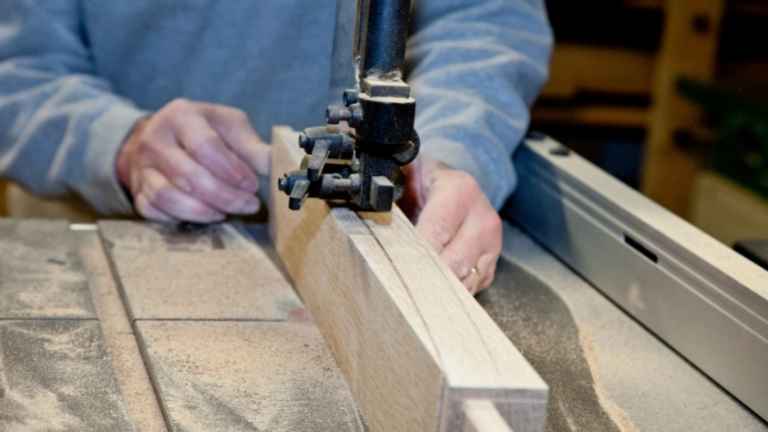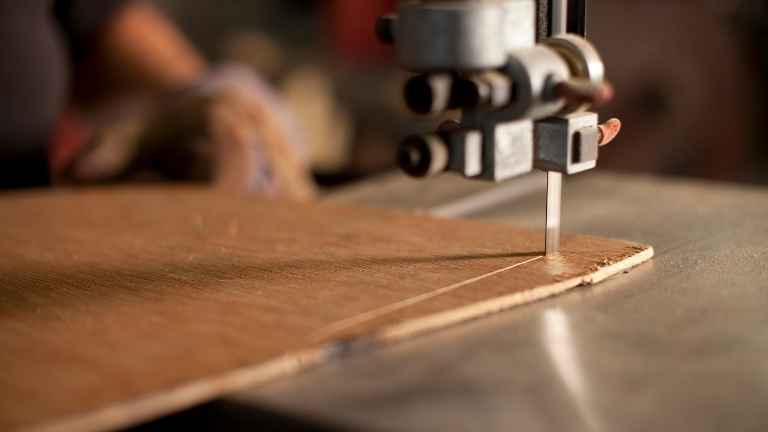Is your bandsaw not cutting straight? If you are having trouble with the blade following a smooth and even path, there may be an issue that needs to be addressed.
Before calling for help or trying to figure out a way to fix it yourself, take some time to review these common problems and what they mean.
The more familiar you are with the parts of your machine and how they work together, the easier it will be to recognize what’s wrong when something goes awry.
It can feel like our tools always break at the most inconvenient times; but if we know which problem is affecting us, then we’ll have better luck fixing it!

Reasons Behind Bandsaw Not Cutting Straight
Here are the common reasons for bandsaw finding it difficult to cut straight-
1. The Blade Needs Replacement
If the blade is dull, uneven, chipped, or cracked – it’s time to replace it. This is the most common reason behind a saw not being able to cut in a straight line.
The right bandsaw blades are designed for specific tasks and what they’re made of affects how easily and efficiently they cut through wood. So, if you’ve just gotten a new project that requires a different type of blade than what you typically use on your machine, then this could be an issue too.
Buying replacement blades can seem expensive at first glance but in reality, changing them will help prolong the life of your saw and prevent more costly repairs down the line!
It might also make sense to buy some extra spare blades so that when one has been replaced, there’s another ready to go without being caught up waiting for shipping or ordering online again.
2. Faulty Blade Installation
Doing things wrong in blade installation can cause the issue as well. For cutting in a straight line, the blade and fence should be aligned as close to 90 degrees as possible. One of the most common errors in installation is not using a square when assembling the saw’s table with its miter slots.
This will cause an out-of-square cut, which can make your workpiece wonky or wavy. You’ll first need to measure from one corner of the blade opening (or slot) to another–one on either side of where you want your edge guide positioned for cutting purposes–and then use a carpenter’s square to draw a line extending through both points. Now attach that point on the board/plywood being used for rip cuts by drilling two pilot holes into it, inserting screws at those locations, and tightening them down.
3. The Saw is Installed incorrectly
If you have installed the saw on an uneven or unstable place, the saw won’t be able to provide the best result. For the bandsaw to work perfectly, you’ll need a stable base that will hold the saw perfectly in place while it operates.
Many people ignore this and think the saw is faulty or not working. For making the saw stable on its base, you’ll need to make sure the base is level, and it’s not moving or vibrating significantly when the blade is in motion.
4. Blade Tension Needs Adjustment
If your bandsaw blade is not cutting straight, the first thing to check is if you need to adjust the tension on it. Often times a loose blade will allow more flex and can cause an uneven cut or vibration in the saw. This can be done by using one of these two methods:
Method A)
Using a wrench that comes with most band saws; turn clockwise tightening as needed until there’s no slack when testing for tightness. Turn counter-clockwise loosening as needed until resistance is felt while trying to make the blades touch each other from where they are currently set too far apart (thickest). The goal here is for those teeth near either end of both blades to just barely but gently touch at their tips.
Method B)
With the blades moving, feel for slight contact near one end of each blade and then turn that screw a quarter-turn clockwise or counterclockwise to get it closer to touching as needed. Continue doing this until you reach the desired tightness (a few teeth apart at their closest point). Repeat on the other side using that blade’s adjustment screws.
5. Saw Wheels Needs Adjustment
If you notice that your blade is not cutting perfectly straight, it could be due to the adjustment of the saw. If there are too many teeth on one side or if some teeth have been removed from a wheel this will affect how well the machine can cut in either direction. You should check these things periodically as they wear down over time and need readjustment.
In some cases, we noticed that the wheel was not perfectly straight and hence, the blade was not remaining stable in one place. If this happens, despite doing everything perfectly, you won’t be able to have perfectly straight cuts.
6. Issue with Fence, Table, or Blade Guides
This can be because of issues with the blade guides, fence, or table as well. So, check these things one by one to see if these tools are working perfectly. Sometimes, a slight deviation of shape in these tools can cause the issue. That’s why you need to careful while dealing with these materials. You can’t just abuse these tools like many others in your workshop. You’ll simply ruin things for everyone.
If these methods fail, try adjusting your band saw table instead by loosening all four of its bolts with an adjustable wrench while holding back some pressure against any movement or wobble in those guides so they don’t shift positions; tighten them again after making adjustments to find what feels best about how stable it is when cutting wood pieces being fed into it.
Fixing the Bandsaw Won’t Start Issue
If your bandsaw was working properly the last time you used it, here are some of the common reasons that may be preventing it from starting now-

1. Loose Connection
Make sure you have disconnected the electrical cord from the power source, then remove it. Check that all connections are tight and secure at both ends of the cable before plugging in again to make sure there is no loose socket or frayed wiring.
If your bandsaw has a manual start function, look for any resistance when trying to move the handle back and forth- this may be because some debris became lodged between teeth on either side of the blade which will need removing with pliers first.
When starting manually after clearing obstruction, try reversing direction if you only get one revolution initially (and hopefully more). If not successful still turn off the machine as soon as possible without injury so safety guards can shift into place.
You should also check whether your blade is still in good condition. If not, it may need to be sharpened or replaced before you can get a straight cut again.
2. Dead Battery
A dead battery in a cordless bandsaw can cause the motor to not turn on at all.
For a corded bandsaw, the power cable may need to be unplugged before you can use it again.
3. Blade Jammed
Blade jammed below the table on a bandsaw can be caused by dirt or debris in between the blade and guard.
If this is your issue, you will need to remove whatever has clogged it from under the table first before trying to solve other problems.
Also, check for any obstructions that may have fallen onto one of the rails and blocked movements like wood chips or shavings left over from earlier work.
Another common cause could be an improperly tensioned blade which requires loosening or tightening via screws near where blades meet at the center pivot point (usually on top). You should also consider moving the saw carriage back further than normal in order to give room for adjustment if needed.
Finally, make sure there are no loose parts around the blade or guard, as this can also cause issues.
If none of these tips are helpful, consult the manual for troubleshooting instructions on how to get your bandsaw up and running again in no time!
Read: Table Saw vs Miter Saw vs Circular Saw vs Band Saw Compared
4. Motor Has Issues
If your bandsaw is still not turning on, the motor may be at fault. If the motor is bad, then there is probably no way to fix it yourself without claiming the warranty or getting professional service.
Don’t panic, it may be just a minor issue in the motor or some internal wiring has blown away. Either way, you should get things fixed by contacting professionals.
Conclusion
We hope these simple tips help you navigate your way through the troubleshooting process to solve any problems with your bandsaw. If none of these steps work, it’s time to call in a professional.
They may be able to diagnose and fix whatever is wrong with your machine.
If you need assistance or have questions about anything else related to this topic–just contact us via email, live chat, phone, or our website form!
Leave a Reply